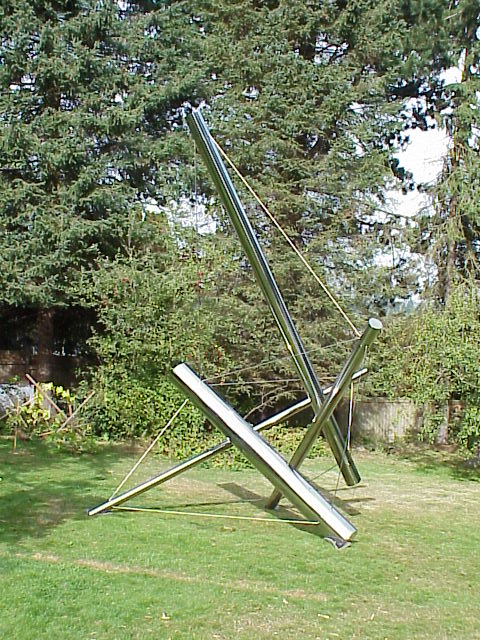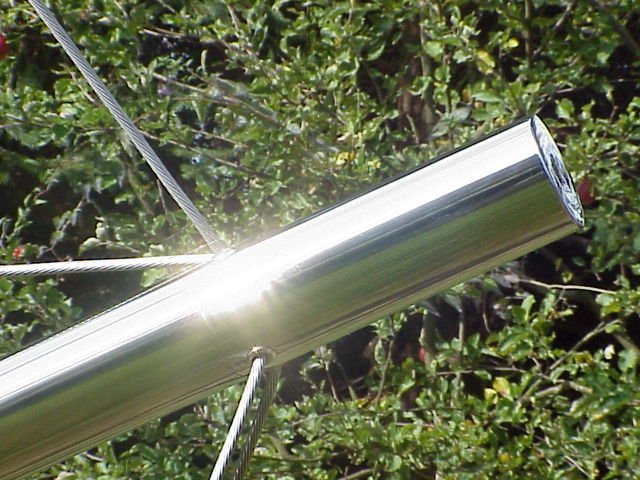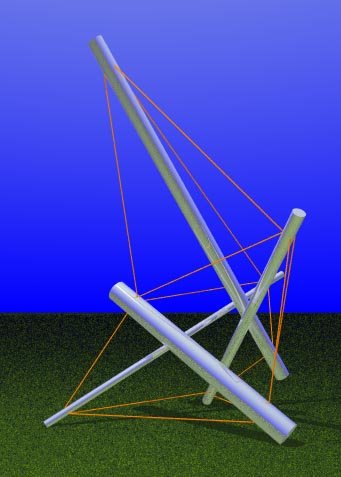
Indexer II by Kenneth Snelson

On November 7, 2001, I received a query from Kenneth Snelson associate Philip Stewart about my tensegrity design system, and I quickly replied. Stu replied saying he'd send a sample sculpture along for me to analyze when he returned from his holiday. I replied indicating my interest, and indeed later I got a query from him asking what sort of drawing formats I could handle. None of the formats he sent sounded like something I had worked with, though certainly I'd heard of AutoCAD, so I replied with POVRAY as an alternative and a willingness to do my best to field whatever he sent. He replied with a windows metafile that AutoCAD exported. I sent an acknowledgment, and, after some searching through my software, it turned out that Adobe PhotoDeluxe could handle WMF files gracefully and I found myself looking at the schematic. Due to Ken's concerns about plagiarism, I won't reproduce it here.
Later Stu sent along some photos as well, and I finally learned the small sculpture was called Indexer II. The title photo above and the following photo detailing a hub were among the pictures.

Detail of Hub on Indexer II
I sent an acknowledgment, and some time later sent Stu an email with the prestress data (member weights not yet factored in) I had computed with my software. In March, 1994, I had started experimenting with doing computations for complex hubs, and that turned out to be very useful for analyzing this sculpture. The first edition of my book -- completed late in 1994 -- had made the usual assumption that the hubs are single points, but I had realized that if I was going to really be practical I needed to incorporate assumptions about the geometry of the hubs. I was able to rely on the software to position the cable attachment points so they were at the optimum locations. Stu must have gone through a similar process because my results matched his very closely. To show Stu we were on the same wavelength, I also sent along the following raytrace rendering I did of the sculpture using the data from my software:

Raytrace Realization of Indexer II
Raytrace generated by Bob Burkhardt
He later sent an acknowledgment which I was relieved to find stated his results matched mine; however, I was not able to decypher his attached pdf which compared his results and mine. In response to my plea, he sent along the original Excel file which I was able to look at, if only in the library. For your benefit, I reproduce it in HTML. I don't know what my problem with the pdf was as now I'm able to display it fine. Probably an obsolete version of Adobe Reader.
Integrating the weight data into my numbers was a different story. While the form-finding part of my software could deal fine with complex hubs, the exogenous load analyzer hadn't kept up and was completely incapable of dealing with the model with complex hubs. Stu kept in touch while I was figuring out what to do, sending me an email when his address changed. I responded with interest to his idea of continuing the analysis with a large dragon sculpture. I finally put together my analysis and mailed it from my channel1 address to Stu's old hotmail address on April 16, 2002. I never got a response.
The analysis pointed up to me the fact that the exogenous load analysis portion of my software needed to catch up with the rest. When I got laid off from my job at Lycos toward the end of October, 2002, I made updating the software my number one priority along with developing a second edition of my book. It turned out a lot of theoretical analysis was necessary as well, and that went into the book. I finally came up with theory and software that satisfied me. On August 30, 2004, I returned to the analysis I'd done for Stu and put together a second draft based on my recent research. It was for my benefit only, until now anyway. Some references in it are only meaningful to me, but these are few and I hope it's generally understandable.
Except for the raytrace, all images and the INDEXERCABLE spreadsheet are courtesy of Philip Stewart.


